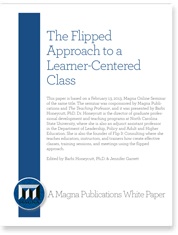“Students in inverted classrooms need to have more space to reflect on their learning activities so that they can make necessary connections to course content” (Strayer, 2012).
Read more ›CURRENT ARTICLE • February 17
OTHER RECENT ARTICLES
It used to be called team teaching, but that term is now used less often to describe the collaboration of colleagues when they jointly teach the same course. Multiple instructors may be involved in the course, each delivering a freestanding module; or two instructors may do the course together, each in class every day with all course activities and assignments integrated. And there are variations of each of these models.
Read More › The following is an excerpt from the whitepaper “The Flipped Approach to a Learner-Centered Class.”
The following is an excerpt from the whitepaper “The Flipped Approach to a Learner-Centered Class.”
 There’s lots of research documenting the positive effects of group experiences on learning outcomes. Less is known about the specific aspects of group experiences that contribute to their overall positive impact. Thomas Tomcho and Rob Foels decided to explore this question by looking at the research on group learning in the field of psychology, as reported in the journal Teaching of Psychology.
There’s lots of research documenting the positive effects of group experiences on learning outcomes. Less is known about the specific aspects of group experiences that contribute to their overall positive impact. Thomas Tomcho and Rob Foels decided to explore this question by looking at the research on group learning in the field of psychology, as reported in the journal Teaching of Psychology.
Blended learning entails more than simply replacing class time with online course elements or supplementing an online course with face-to-face meetings. To be successful, the online and face-to-face modes need to be integrated by taking into account the learning objectives and the affordances of each mode and deliberately linking what occurs in each mode.
Read More ›In more than 20 years of teaching, I have learned that too much information frustrates rather than inspires students. Today, however, with a few clicks of the computer mouse, any teacher can retrieve an overabundance of information. What is more, courseware makes distributing this information to students amazingly easy. As a result, teachers risk (unintentionally) giving students much more information than they can reasonably digest, including electronic texts, supplementary texts, and background information. The key to avoiding information overload is remembering course goals.
Read More ›The body of evidence documenting the effectiveness of cooperative learning is already impressive. The large and regularly cited meta-analysis of Johnson and Johnson published in 1987 reviews 378 studies that explore the use of cooperative learning groups in a wide range of settings. More than half of the studies reviewed favored cooperation in groups compared with only 10 percent favoring individual effort.
Read More ›Last semester I implemented a different kind of final exam. In the past I have used the standard multiple-choice and short-answer exams. I was thinking about making a change when I discovered Beyond Tests and Quizzes: Creative Assessment in the College Classroom, edited by Richard J. Mezeske and Barbara A. Mezeske. The second chapter, “Concept Mapping: Assessing Pre-Service Teachers’ Understanding and Knowledge,” describes an assessment method that tests higher-level thinking. The author shared his experience using concept maps as a final exam, included an example of the final exam project, offered rubrics for grading, and discussed the advantages and disadvantages of the strategy. I decided this was the change I was going to make.
Read More ›It seems like everyone is talking about the flipped classroom. But how do you use this new model to construct lessons and assessments that reinforce student learning?
Read More › Teaching to students’ strengths and interests can promote creative and critical thinking. But requesting creative responses often engenders the exact opposite of creativity. “Just tell me what you want me to do and I’ll do it.” “How many words does it need to be?” “What should I write about to get a good grade?” “I’m not creative.” Often these comments are accompanied with sighs, groans, or no responses at all (in the case of online students), indicating just how much students resist when asked to be creative. And these responses are even more prevalent in required and prerequisite courses. So how do we overcome the resistance and encourage creative ideas and thinking from our students?
Teaching to students’ strengths and interests can promote creative and critical thinking. But requesting creative responses often engenders the exact opposite of creativity. “Just tell me what you want me to do and I’ll do it.” “How many words does it need to be?” “What should I write about to get a good grade?” “I’m not creative.” Often these comments are accompanied with sighs, groans, or no responses at all (in the case of online students), indicating just how much students resist when asked to be creative. And these responses are even more prevalent in required and prerequisite courses. So how do we overcome the resistance and encourage creative ideas and thinking from our students?





